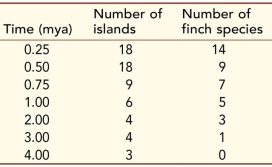The different finch species in the phylogeny shown in the 22.8 of the textbook have all evolved on islands of the Galápagos archipelago within the past 3 million years.Molecular clock analysis (see Chapter 23) has been used to determine the dates of the various speciation events in the phylogeny.Geological techniques for dating rock samples (see Chapter 24) have been used to determine the ages of the various Galápagos islands.The table shows the number of species of Darwin's finches and the number of islands that have existed in the archipelago at several times during the past 4 million years.  If no more islands form in the Galápagos archipelago, do you think that speciation by geographic isolation will continue to occur among Darwin's finches? Why or why not? What additional data could you collect to test your hypothesis (without waiting to see if speciation occurs)?
If no more islands form in the Galápagos archipelago, do you think that speciation by geographic isolation will continue to occur among Darwin's finches? Why or why not? What additional data could you collect to test your hypothesis (without waiting to see if speciation occurs)?
Correct Answer:
Verified
View Answer
Unlock this answer now
Get Access to more Verified Answers free of charge
Q128: Refer to the figure. Q129: In the eastern United States, populations of Q130: The species concept that is best for Q131: While studying colorful spiders on the Hawaiian Q132: The morphology and natural history of a Q134: The lineage species concept could be represented Q135: If allopatric speciation is the most prevalent Q136: The biological species concept is best suited Q137: Refer to the figure. Q138: The biological species concept means that species![]()
![]()
Unlock this Answer For Free Now!
View this answer and more for free by performing one of the following actions

Scan the QR code to install the App and get 2 free unlocks

Unlock quizzes for free by uploading documents